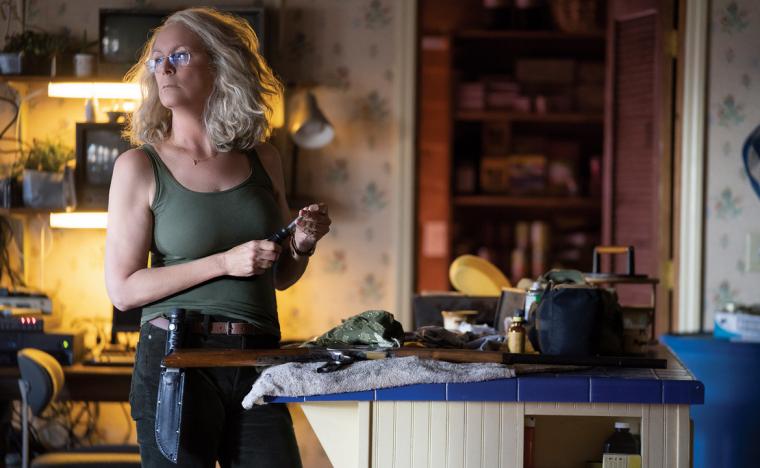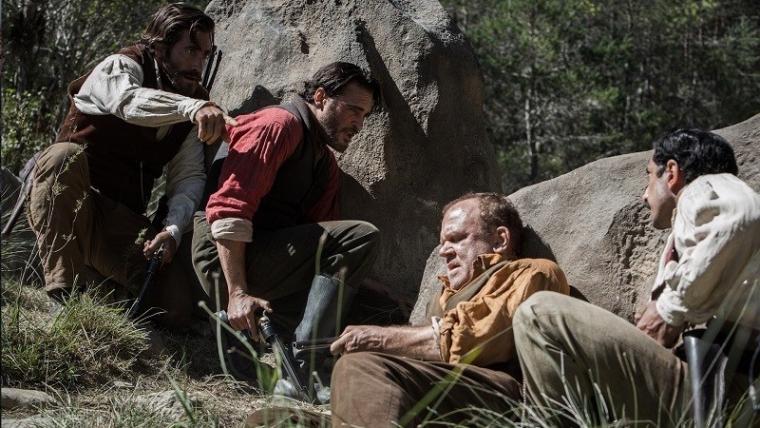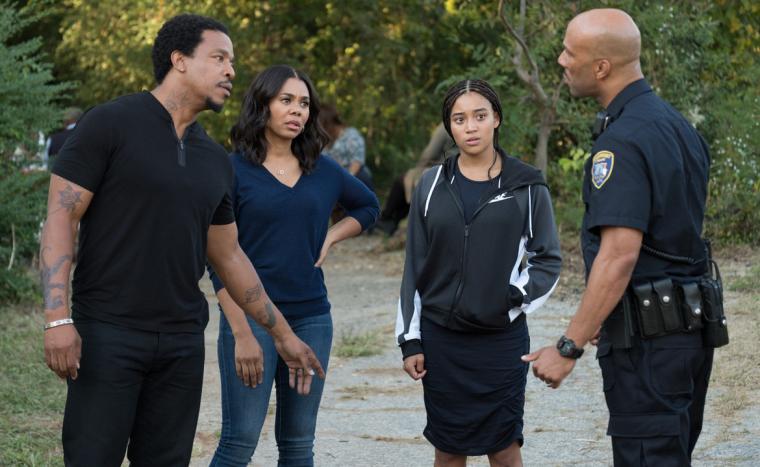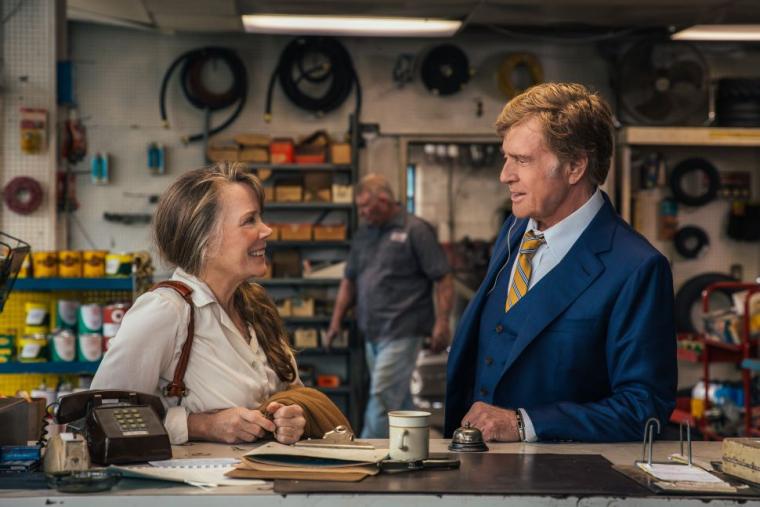
HALLOWEEN
John Carpenter's 1978 Halloween survived five direct sequels, each less effective than the one that came before. It survived the 1998 reboot Halloween H20: Twenty Years Later, as well as that film's own sequel – the one that had the temerity to kill off Jamie Lee Curtis' heroine Laurie Strode in its first 15 minutes. It survived Rob Zombie's 2007 Halloween, an attempt to empathize with babysitter killer Michael Myers, plus Zombie's 2009 follow-up, an equally misguided but far more interesting movie. And it'll survive writer/director David Gordon Green's current, mostly lousy Halloween, too, though why it should have to is another matter entirely. What did Carpenter's spare, elegant, terrifying little slasher flick do to warrant such continued besmirchment of its good name?
The original Halloween is kind of like that amazing recipe of your grandmother's that the woman forgot to write down before her passing, and that you and your family keep trying to replicate without ever getting the ingredients quite right. Green's Halloween has the ingredients – including a do-over resurrection for Curtis' Laurie – but no one seems to have figured out the portioning. It's now 40 years later, and Michael, who hasn't spoken a word since his 1978 mental-asylum incarceration, escapes from a bus crash to resume his life of suburban annihilation. Laurie, meanwhile, has for four decades been patiently prepping for Michael's return with an ass-load of artillery and attitude. There's your meat; just add teens in peril, stymied cops, a portentous psychiatrist, three endlessly repeated piano notes, and stir.
Yet there's nothing stirring about Green's movie, chiefly because it isn't even a little bit frightening. When Zombie was given the franchise reigns in 2007, the choice made sense, considering his films House of 1000 Corpses and The Devil's Rejects were frightening, as well as deeply unsettling and mired in a 1970s aesthetic that you could imagine translating beautifully to Carpenter's lean and mean original – even if, in the end, it didn't. But exactly what in Green's filmography made Universal Studios think he'd be the ideal director to continue, and pay homage to, the legacy of an iconic horror smash? Pineapple Express? Jonah Hill's The Sitter? The Jake Gyllenhaal weepie Stronger? It would be like giving the job of remaking Some Like It Hot to … . Well, to John Carpenter, actually. Although Carpenter would at least have better instincts about where to position his camera.
Green does pull off one terrific callback to the finale of Carpenter's film, when Michael (or rather “The Shape,” embodied here by James Jude Courtney and, on occasion, the original Shape Nick Castle) stares down at the immobile Laurie in the front lawn, and after briefly turning his head, he looks again to see that she's vanished. And a few images do boast a fair degree of menace, as when Michael stands motionless – as if there were any other way for him to stand – on a foggy road behind a police cruiser. Yet even with Carpenter's instantly recognizable Halloween score forever goosing the action, Green doesn't display any particular flair for horror or anxiety during the innumerable, predictable, boring murders or their tracking-shot lead-ins, and the violence is so needlessly gory that the effects team appears to be doing far more work than their director. Like a lot of viewers, probably, I was happy to see a particularly odious figure get his head smashed in by the underside of Michael's boot. That didn't mean I needed to see the guy's leaking brain matter on quite so many subsequent occasions. Getting an audience to squeal “Ew-w-w-w!!!” is easy. It's getting us to shriek “A-a-a-a!!!” that's hard.

Does the movie at least do right by Jamie Lee Curtis? No, unless you consider her mere return a victory, which I don't. (In general, I'm not wild about sequels pretending that previous sequels didn't exist – franchise entries should be forced to own their predecessors' stupid mistakes and work their way through them.) Curtis gives the film what intensity and professionalism she can, and Laurie has been given just enough backstory – two failed marriages, a drinking problem, a daughter (Judy Greer) and granddaughter (Andi Matichak) worried about her mental stability – to make it seem like “depth of character.” But the film proves thunderously uninterested in Laurie Strode as a human being. We really have no idea what, aside from slowly losing her mind, Laurie has been up to over 40 years: how she earns a living; what treatment she received to work through her tragedy; how she was able to afford a heavily fortified – and prohibitively expensive – domicile that looks to have been designed by Jigsaw himself. Michael's the killer, and Laurie's the survivor, and that's all there is to it. But it would've been nice if something beyond nostalgia put us in our heroine's corner from the start. Sadly, though, Laurie winds up as nothing more than a well-acted cipher, one sitting alongside the other well-acted ciphers played by Greer, Matichak, Will Patton, Drew Scheid, and the enjoyably odd young comic Miles Robbins.
Robbins, though, isn't the only comic to be found in Green's continuation, and the only time I was really startled by Halloween was when I realized its funny moments were playing infinitely better than its purportedly scary moments. One of the film's screenwriters is Green's friend and frequent collaborator Danny McBride, and anyone guessing that the star of HBO's Eastbound & Down would prove as mismatched with the project as Green himself likely wasn't wrong. But if it was McBride who was responsible for the movie's random detours into pure, joyous silliness – the eccentric ramblings of Toby Huss as Laurie's son-in-law, the adorably bickering cops fighting over a Vietnamese PB&J, the loving jokiness between babysitter Vicky (Virginia Gardner) and her hilarious charge Julian (Jibrail Nantambu) – I absolutely applaud his participation. With this film's massive box-office weekend all but mandating yet another sequel, and one that'll no doubt land sooner rather than later, I might not even dread a Halloween II: This Time, It's Julian.

THE SISTERS BROTHERS
At six-foot-two, with his sturdy build and doughy features, John C. Reilly is one of the great gentle giants in American movies. Despite playing occasional villains, the actor always looks in need of a hug, or like he's two seconds away from launching into a heartbreaking rendition of “Mr. Cellophane,” and Reilly's air of beaten-up kindness may never have been put to better use than it is in director Jacques Audiard's first-rate Western The Sisters Brothers.
Reilly and Joaquin Phoenix play the titular Eli and Charlie Sisters, a pair of Oregon-based, bounty-hunting assassins almost comically mismatched as siblings – Eli pragmatic and even-tempered, Charlie hot-headed and frequently soused. (Suffering from one particularly nasty hangover, Charlie slides right off his horse mid-ride.) Their latest bounty, on the orders of a sinister tycoon known only as The Commodore, is the fabulously named Hermann Kermit Warm (Riz Ahmed), a dignified gold prospector who, in the film's 1851 setting, is also being tailed by dandified detective John Morris (Jake Gyllenhaal). Much of the movie finds Eli and Charlie in lukewarm pursuit of Hermann and the tag-along John, and as an R-rated Western, The Sisters Brothers is expectedly rife with salty language, acts of shockingly brutal violence, and demonstrations of daily life as period-piece gross-outs. (While I winced at some of the carnage, the image that truly horrified me was that of a spider crawling into the mouth of a sleeping Eli, who, upon awakening, looks like death until he pukes up a bloody mouthful of hatched arachnid babies.) Amazingly, however, the overall mood of Audiard's film is one of contemplative wonder, a surprise made all the sweeter by Reilly's forcefully tender performance.

The Sisters may be killers, and awfully good at their jobs, but they're hardly cold-blooded; even their spiky banter and incensed outbursts are suffused with genuine affection, and in their more thoughtful moments, you can feel both brothers longing for a more substantial existence than the one they're stuck in. And while the acquaintance between Hermann and John goes through numerous iterations – with viewers treated to an old-timey Nightcrawler reunion in the pairing of Ahmed and Gyllenhaal – the men eventually find a common ground that's as touching as it is unanticipated. (Part of Hermann's grand plan involves the establishment of a peaceful Utopia in Dallas, Texas. Good luck with that, man.) From the glorious vistas shot by cinematographer Benoît Debie to Alexandre Desplat's alternately elegiac and lively score, Audiard's outing comes across as both mournful for the past and strangely optimistic about a less-savage future. It consequently makes absolute sense when our four protagonists finally meet and, fittingly, don't quite know what to do – a situation that's as legitimately unnerving as it is narratively exciting.
All told, this beautifully directed, marvelously acted Western does well by its cross-country treks, shoot-outs, and additional genre staples, among them the token whorehouse proprietor and hooker-with-a-heart-of-gold whom Rebecca Root and Alison Tolman portray with admirable honesty. But The Sisters Brothers does even better by its genre-defying big-heartedness, a quality best exemplified by Reilly as a fundamentally decent man long ago roped into an indecent life, and one ceaselessly awed by what miracles the years ahead may bring. Few screen images this year have filled me with as much goofy happiness as that of Eli Brothers, dutifully reading the instructions, learning to use his first toothbrush – though even that ticklish sight may have been topped by Eli's later delight during his first stay in a San Francisco hotel. Who needs a career of gunslinging and murder when you finally have access to a toilet that flushes?

THE HATE U GIVE
A YA-lit adaptation that aspires to be a tougher-minded work than it actually is, director George Tillman Jr.'s The Hate U Give concerns 16-year-old Starr Carter (Amandla Stenberg), a smart, centered, lower-middle-class African-American who witnesses her lifelong friend Khalil (Algee Smith) gunned down by a white police officer, and whose life is upturned when she's consequently asked to testify in front of a grand jury. With screenwriter Audrey Wells adapting Angie Thomas' novel, the situation is incredibly fraught. If Starr defends her friend's honor, she'll not only be an immediate pity case with her mostly white fellow students, but will earn the ire and retribution of her neighborhood's resident drug kingpin (Anthony Mackie) who employed Khalil during his final months. If she doesn't testify, she'll lose the hard-won dignity that her parents (Russell Hornsby and Regina Hall) have instilled in her. And Lord how I wish the movie had the strength of its aspirations, because for all of its truly moving moments, Tillman's film is still YA through and through.
This isn't a wholly bad thing, especially when you have a lead as magnetic and soulful as Stenberg, the intensely gifted star of last year's YA romance Everything, Everything who commands the screen with humanity, empathy, and an almost preternatural depth of feeling. Everything – everything! – Stenberg does here is sublime, as are Hornsby's riveting declarations of worth, Hall's expressions of maternal concern, and Issa Rae's no-nonsense advice as an activist lawyer. (Starr's uncle, by the way, is played by a fierce and focused Common, meaning that between him, Hornsby, and Hall, our teen protagonist comes from the most outstanding genetic code imaginable.) The film is also hugely effective at showing the insidiousness of privileged white protest; when demonstrating against the killing of Khamil, most of Starr's classmates don't even pretend it's about anything other than having a “legitimate” reason to cut class for the day.
Yet Tillman doesn't do nearly so well by Starr's peers on both sides of her figurative SoCal tracks – teens who come off as blandly one-dimensional, or, in the case of Starr's white boyfriend Chris (K.J. Appa), even a little off-putting. (It takes a long, long time to accept that Chris' blatant appropriation of black culture and fundamental cluelessness – “I've got color on the inside, where is counts!” – is meant to be endearing, and not a major red flag.) And while many of the film's problems, principally Mackie's under-imagined subplot and the unfortunately happy-face finale, no doubt stem from the source material, Tillman's outing still proved too YA for this viewer's comfort; I was kind of exhausted by its voice-over narration, slow-motion flourishes, easy stereotyping, and pop- and hip-hop-laced soundtrack before the movie was even 15 minutes old. That being said, though, The Hate U Give is worth a look merely for the insanely talented Stenberg, and maybe worth several looks for its target demographic for whom its messages can never be repeated often enough. It may have Hate in the title, but there's a lot here to love.

THE OLD MAN & THE GUN
As has been widely reported, Robert Redford claims that Forrest Tucker – the inveterate bank robber at the heart of A Ghost Story director David Lowery's The Old Man & the Gun – will be the last role the 82-year-old icon ever plays on-screen. It's temping to say that Forrest Tucker is the only role Redford has ever played on-screen, given how perfectly the character, or at least this particular conception of him, meshes with everything Redford has consistently been over more than a half-century in movies: charming, intelligent, deferential, inscrutable, blond. After Daniel Day-Lewis announced that Phantom Thread would mark his retirement from film acting, I left my screening already bemoaning all the varied, phenomenal Day-Lewis performances we'd never get to see. Leaving The Old Man & the Gun, though, I just felt, “Yeah, it's time,” because as lovely as Redford is in the film, how much longer could Hollywood's star pony possibly pull off his one trick?
Lowery's film, a reunion between Redford and his Pete's Dragon director (currently playing at Iowa City's FilmScene), follows Forrest through a bunch of 1981 robberies and a potential romance with Sissy Spacek's widow Jewel while Casey Affleck's dogged detective John Hunt endeavors to track him down. If I added “And that's it,” that wouldn't be correct – but wouldn't be entirely incorrect, either. We're given a lot of incident involving Redford's über-courteous robber, but no real understanding – nothing that gives us a sense of why the man spent his life, from age 13 on, pulling off one heist after another. (And, in the process, escaping from juvenile-detention centers and prisons, including San Quentin, a staggering 16 times, a feat shown here in a fantastically clever montage.) Lowery's gentle dramedy very much wants us to believe that Forrest committed his crimes for the sheer fun of it, and I'll agree there's something both endearing and kind of radical about the decision to explore the actions of an aged career criminal who's only it it for the smiles. But given even less to work with, Spacek creates a radiantly alive figure, Affleck projects Hunt's renewed career enthusiasm and giddy curiosity, Elisabeth Moss performs emotional wonders in just one scene, and Tom Waits, as one of Forrests allies, delivers beautifully earthy readings that fashion an entire, richly drawn character out of a few simple reminiscences. (Waits' unnecessary yet also deeply necessary monologue about why his bank-robbing 66-year-old hates Christmas is one for the ages.) Redford, though? Redford is, as always, Redford – smooth, courtly, both amusing and amused, and almost pathologically unknowable. There are narrative holes in The Old Man & the Gun, but none as deep as the hole at its center – though you could definitely argue that for the blithely entertaining film he's in, and for the star's legion of fans, he's giving Lowery's latest exactly the unthreatening comfort food it requires. Surveying a diner that he figuratively imagines robbing, Redford tells Spacek that the locale isn't his style. “You have a style?” she playfully asks, to which he responds with a forthright “I do.” For better and worse, he sure does.










